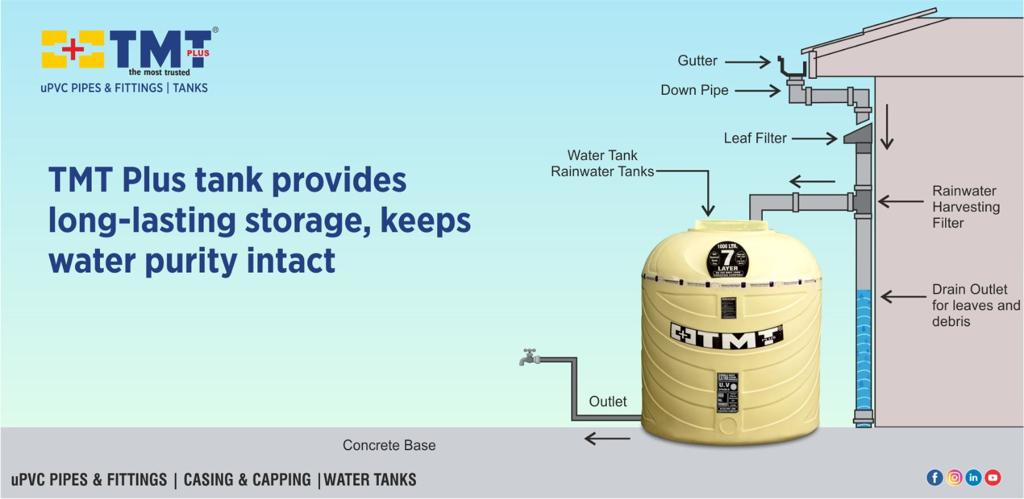 Rainwater harvesting is a system designed to conserve rainwater by gathering, storing, and purifying the rainfall runoff from rooftops, parks, and various other sources. The collection and storage of rainwater, whether it occurs naturally or is channeled from artificial catchment areas such as rooftops, compounds, rock surfaces, and similar locations, constitutes a rainwater harvesting system.
Rainwater harvesting is a system designed to conserve rainwater by gathering, storing, and purifying the rainfall runoff from rooftops, parks, and various other sources. The collection and storage of rainwater, whether it occurs naturally or is channeled from artificial catchment areas such as rooftops, compounds, rock surfaces, and similar locations, constitutes a rainwater harvesting system.The major parts of Rainwater Harvesting system include:
1. Catchment: The catchment area serves the dual purpose of collecting and storing rainwater that has been captured.
2. Conveyance system: This system facilitates the transfer of harvested water from the catchment to the recharge zone.
3. Filter: The filtration component of the system is responsible for gathering rainwater and eliminating contaminants.
4. Tanks and Recharge Structure: These structures are utilized for storing purified water that is ready for use. Choose a robust water tank such as the TMT Plus 5 layer water tank for effective protection from natural elements.
5. Conveyance pipes: Connect downspouts to conveyance pipes leading to the tank with a gentle slope for efficient water flow.
6. Overflow and outlet: Prevent overflow with an outlet diverting excess water. Connect an outlet for distributing harvested water.
7. Filtering and purification: Install additional filters or purifiers for potable water use if needed.
Factors that play an important role in the effectiveness of Rainwater Harvesting system
The efficiency of rainwater harvesting hinges on a host of factors. The volume of rain runoff is influenced by the intensity of precipitation and the type of surface tells about the harvestable water quantity. The characteristics of catchment areas, encompassing topography, land use, and vegetation play a decisive role in water collection efficiency.
The effects on environment are also an important reason to consider, necessitating a careful approach to prevent disruptions or unintended consequences. The technology used, ranging from basic setups to advanced systems with filtration mechanisms, significantly influences effectiveness. Adequate storage tank capacity, such as of 7 layer water tank ensures water storage is hygienic and pure during low rainfall periods.
Roof attributes, including material, slope, and surface area, impact both the quantity and quality of harvested rainwater. The total rainfall of the region directly correlates with the potential harvestable water, serving as a fundamental determinant of the system’s overall effectiveness. Considering all these factors, a holistic consideration is crucial for optimizing rainwater harvesting systems.
Points to consider while installing the best PVC water tank in Rainwater Harvesting:
1. Elevated positioning: Place the PVC water tank at an elevated location to utilize gravity for natural water flow, ensuring seamless distribution through gravity-fed systems.
2. Proximity to catchment areas: Opt for a location near catchment areas, such as rooftops, to minimize piping requirements and enhance the efficiency of rainwater collection.
3. Solid foundation: Ensure the tank is situated on a stable, level foundation to prevent structural issues, facilitating easy maintenance and inspection.
4. Easy accessibility: Choose a location that allows convenient access for routine tasks like cleaning and inspection, promoting efficient maintenance and potential upgrades.
5. Connection to gutters and downspouts: Establish a connection between the PVC tank and catchment area gutters and downspouts, incorporating a first flush diverter to redirect initial runoff and prevent debris entry.
Benefits of installing TMT Plus best-grade PVC water tanks:
Our products stand out with their unique selling propositions, including features such as the prevention of biofilm formation, maintaining a consistent wall thickness, and ensuring air-tightness with threaded lids, and are crafted from high-quality LLDPE resin, all the while maintaining an odorless quality.
Some of the other benefits are:
1. Cost-effective solution: PVC water tanks are more affordable than alternative tank materials, providing a cost-effective solution for rainwater storage.
2. Lightweight and easy installation: PVC tanks are lightweight, making them easy to transport and install. This characteristic simplifies the installation process and reduces the need for heavy machinery.
3. Durability: It is a durable material that is resistant to corrosion and rust. This durability ensures a longer lifespan for the water tank, reducing maintenance and replacement costs.
4. UV resistance: Many PVC tanks are designed with UV-resistant properties, protecting the stored water from the harmful effects of sunlight and maintaining water quality over time.
5. Flexibility in design: PVC water tanks come in various shapes and sizes, offering flexibility in design and installation. They can be customized to fit different spaces and accommodate specific storage needs.
6. Resistance to chemicals and contaminants: PVC is resistant to various chemicals and contaminants, providing a safe and reliable storage option for rainwater without the risk of contamination.
7. Low maintenance: PVC water tanks require minimal maintenance. They do not corrode, and their smooth surfaces inhibit the growth of algae, reducing the need for frequent cleaning.
8. Temperature regulation: PVC tanks offer better temperature regulation compared to dark-colored tanks. They help prevent excessive heating of the stored water, preserving its quality.
9. Ease of transportation: The lightweight nature of PVC allows for easy transportation, making it convenient for delivery to various locations.
10. Sustainability: PVC is a recyclable material, contributing to environmental sustainability. At the end of its life cycle, the PVC can be recycled, reducing its impact on landfills.
Among the leading water tank manufacturers in India, TMT Plus delivers with its proven track record in high-quality water tank solutions, backed by over six decades of legacy.
